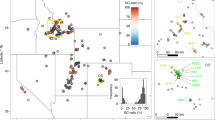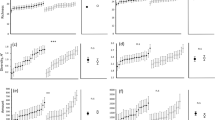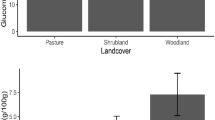Abstract
Significant differences occur in the levels and types of aliphatic glucosinolates in leaves of plants of four Brassica oleracea populations in Dorset. Plants in grassland at St Aldhelm's Head and Winspit have high levels of 3-butenyl glucosinolate, whereas plants of an adjacent population growing on and along the top of cliffs at Kimmeridge have low levels of 2-hydroxy-3-butenyl, 2-propenyl and methylsulphinylalkyl glucosinolates. Plants growing in a variable habitat at Worbarrow Tout have intermediate levels. The differences in occurrence of individual glucosinolates result from allelic variation at four loci. The level of total aliphatic glucosinolates is under more complex genetic control, but is shown to be highly heritable. Allele frequencies at isozyme loci indicate that genetic variation for glucosinolate production is unlikely to have arisen or to be maintained by founder effects or genetic drift. It is suggested that there is selection for high levels of butenyl glucosinolates at St Aldhelm's Head and Winspit because of grazing by generalist herbivores, whereas there is selection for low levels of 2-hydroxy-3-butenyl and other non-butenyl aliphatic glucosinolates at Kimmeridge because of two factors. First, plants effectively escape from generalist herbivores because of physical aspects of the habitat and association with other plant species which provide physical and chemical defences. Thus there is selection for individuals which do not carry the hypothetical metabolic costs of glucosinolate biosynthesis. Secondly, herbivory by specialist cruciferous insects at Kimmeridge, which is enhanced because of the local abundance of B. nigra, selects for individuals which have low levels of 2-hydroxy-3-butenyl glucosinolates.
Similar content being viewed by others
Article PDF
References
Arus, P, and Orton, T J. 1983. Inheritance and linkage relationships of isozyme loci in Brassica oleracea. J Hered, 74, 405–412.
Atsatt, P R, and O'Dowd, D J. 1976. Plant defense guilds. Science, 193, 24–29.
Bailey, N J T. 1959. Statistical Methods in Biology. English Universities Press, London.
Bano, F. 1993. Glucosinolates in Arabidopsis. PhD thesis, University of East Anglia, Norwich, UK.
Bartlet, E, Parsons, D, Williams, I H, and Clark, S J. 1994. The influence of glucosinolates and sugars on feeding by the cabbage stem flea beetle, Psylliodes chry-socephala. Entomologia exp appl, 73, 77–83.
Birch, A N E, Griffiths, D W, and Macfarlane Smith, W H. 1990. Changes in forage and oilseed rape (Brassica napus) root glucosinolates in response to attack by turnip root fly (Delia floralis). J Sci Food Agric, 51, 309–320.
Blight, M M, Pickett, J A, Wadhams, L J, and Woodcock, C M. 1989. Antennal responses of Ceutorhynchus assimilis and Psylliodes chrysocephala. In: Dale, M., Dewar, A., Froud-Williams, R. J., Hocking, T. J., Gar-eth Jones, D. and Rea, B. L. (eds) Aspects of Applied Biology, 23 Production and Protection of Oilseed rape and Other Brassica Crops, pp. 329–334. The Association of Applied Biologists, Wellesbourne, Warwick, U.K.
Bodnaryk, R R. 1992. Effects of wounding on glucosinolates in the cotyledons of oilseed rape and mustard. Phytochemistry, 31, 2671–2677.
Chew, F S. 1988. Biological effects of glucosinolates. In: Cutler, H.G. (ed) Biologically Active Natural Products Potential Use in Agriculture, pp. 155–181. American Chemical Society Symposium, Washington DC.
Doughty, K L, Porter, A J L, Morton, A M, Kiddle, G, Bock, G A, and Wallsgrove, R. 1991. Variation in glucosinolate content of oilseed rape (Brassica napus) leaves. II. Response to infection by Alternaria brassicae. Ann appl Biol, 118, 469–477.
Feeny, P. 1976. Plant apparency and chemical defense. Recent Adv Phytochem, 10, 1–40.
Giamoustaris, A, and Mithen, R F. 1995. Modifying the leaf glucosinolate content of oilseed rape and its effect on its interaction with specialist and generalist pests. Ann Appl Biol, 126, 347–363.
Glen, D M, Jones, H, and Fieldsend, J K. 1990. Damage to oilseed rape seedlings by the field slug Deroceras reticulatum in relation to glucosinolate concentration. Ann appl Biol, 117, 197–207.
Goudet, J. 1995. Fstat V-1.2: A computer program to calculate. F-statistics. J Hered, in press.
Hicks, K L. 1974. Mustard oil glucosides: Feeding stimulants for adult cabbage stem flea beetles, Phyllotreta cruciferae. Ann Entomol Soc Am, 67, 261–264.
Hulme, P E. 1994. Seedling herbivory in grassland: relative impact of vertebrate and invertebrate herbivores. J Ecol, 82, 873–880.
Koritsas, V M, Lewis, J A, and Fenwick, G R. 1989. Accumulation of indole glucosinolates in Psylliodes chrysocephala L.-infested or -damaged tissues of oilseed rape (Brassica napus L.). Experientia, 45, 493–495.
Koritsas, V M, Lewis, J A, and Fenwick, G R. 1991. Glucosinolate responses of oilseed rape, mustard and kale to mechanical wounding and infestation by cabbage stem flea beetle (Psylliodes chrysocephala). Ann appl Biol, 118, 209–221.
Lamb, R J, Palaniswamy, P, and Bodnarkyk, R P. 1991. Selection of oilseed rape with resistance to flea beetles. In: Mcgregor, D. I. (ed.) Proceedings of the Eighth International Rapeseed Congress, 1, pp. 280–285. Groupe Consultatif International de Recherche sur le Colza and Canola Council of Canada, Saskatoon, Sask., Canada.
Louda, S, and Mole, S. 1991. Glucosinolates: Chemistry and ecology. In: Rosenthal, G. and Berenbaum, M. (eds.) Herbivores: Their Interactions with Secondary Plant Metabolites, 1, The Chemical Participants, pp. 123–164. Academic Press, London.
Macfarlane Smith, W H, Griffiths, D W, and Boag, B. 1991. Overwintering variation in glucosinolate content of green tissue of rape (Brassica napus) in response to grazing by wild rabbit (Oryctolagus cuniculus). J Sci Food Agric, 56, 511–521.
Magrath, R, Herron, C, Giamoustaris, A, and Mithen, R. 1993. The inheritance of aliphatic glucosinolates in Brassica napus. PI Breed, 111, 55–72.
Magrath, R, Morgner, M, Bano, F, Parkin, I, Sharpe, A, Lister, C, Dean, C, Turner, J, Lydiate, D, and Mithen, R. 1994. Genetics of aliphatic glucosinolates. I. Side chain elongation in Brassica napus and Arabidopsis thaliana. Heredity, 72, 290–299.
Mitchell, N D, and Richards, A J. 1979. Biological flora of the British Isles. No. 145. Brassica oleracea ssp. oleracea. J Ecol, 66, 1087–1096.
Mithen, R. 1992. Leaf glucosinolate profiles and their relationship to pest and disease resistance in oilseed rape. Euphytica, 63, 71–83.
Mithen, R B G, and Fenwick, G R. 1987. Glucosinolates in wild and cultivated Brassica species. Phytochemistry, 26, 1969–1973.
Mithen, R, Clarke, J, Lister, C, and Dean, C. 1995. Genetics of aliphatic glucosinolates. III. Side chain structure of aliphatic glucosinolates in Arabidopsis thaliana. Heredity, 74, 210–215.
Parkin, I, Magrath, R, Keith, D, Sharpe, A, Mithen, R, and Lydiate, D. 1994. Genetics of aliphatic glucosinolates II. Hydroxylation of alkenyl glucosinolates in Brassica napus. Heredity, 72, 594–598.
Pfister, C A, and Hay, M E. 1988. Associational plant refuges: convergent patterns in marine and terrestrial communities result from differeing mechanisms. Oecologia, 77, 118–129.
Raybould, A F, Gray, A J, Lawrence, M J, and Marshall, D F. 1991. The evolution of Spartina anglica (Gramineae): origin and genetic variation. Biol J Linn Soc, 43, 111–126.
Rodman, J E. 1980. Population variation and hybridization in sea-rockets (Cakile, Cruciferae): seed glucosinolate characters. Am J Bot, 67, 1145–1159.
Rodman, J E, and Chew, F S. 1980. Phytochemical correlates of herbivory in a community of native and naturalised cruciferae. Biochem Syst Ecol, 8, 43–50.
Simmonds, M S J, Blaney, W M, Mithen, R, Birch, A N E, and Lewis, J. 1994. Behavioural and chemosensory responses of the turnip root fly (Delia floralis) to glucosinolates. Entomologia exp appl, 71, 45–57.
Snogerup, S, Gustafsson, M, and Von Bothmer, R. 1990. Brassica sect. Brassica (Brassicaceae) 1. Taxonomy and variation. Willdenowia, 19, 271–365.
Weeden, N F, and Wendel, J F. 1989. Genetics of plant isozymes. In: Soltis, D. E. and Soltis, P. E. (eds) Isozymes in Plant Biology, pp. 46–72. Chapman & Hall, London.
Weir, B S, and Cockerham, C C. 1984. Estimating F-statistics for the analysis of population structure. Evolution, 38, 1358–1370.
Wendel, J F, and Weeden, N F. 1989. Visualisation and interpretation of plant isozymes. In: Soltis, D. E. and Soltis, P. E. (eds) Isozymes in Plant Biology, pp. 5–45. Chapman & Hall, London.
Wills, A B, and Wiseman, E M. 1980. Acid phosphatase isoenzymes of Brassica oleracea seedlings and their application to sib testing in E X. hybrids. Ann appl Biol, 94, 137–142.
Wright, S. 1921. Systems of mating, I–V. Genetics, 6, 111–178.
Wright, S. 1943. Isolation by distance. Genetics, 28, 114–138.
Author information
Authors and Affiliations
Rights and permissions
About this article
Cite this article
Mithen, R., Raybould, A. & Giamoustaris, A. Divergent selection for secondary metabolites between wild populations of Brassica oleracea and its implications for plant-herbivore interactions. Heredity 75, 472–484 (1995). https://doi.org/10.1038/hdy.1995.164
Received:
Issue Date:
DOI: https://doi.org/10.1038/hdy.1995.164
Keywords
This article is cited by
-
Natural control of plant pathogens through glucosinolates: an effective strategy against fungi and oomycetes
Phytochemistry Reviews (2020)
-
A naturally occurring variation in the BrMAM-3 gene is associated with aliphatic glucosinolate accumulation in Brassica rapa leaves
Horticulture Research (2018)
-
Seasonal and herbivore-induced dynamics of foliar glucosinolates in wild cabbage (Brassica oleracea)
Chemoecology (2018)
-
Variations in Pentacyclic Triterpenoids in Different Parts of Four Ocimum Species Using Reverse Phase-High Performance Liquid Chromatography
Proceedings of the National Academy of Sciences, India Section B: Biological Sciences (2017)
-
Effects of population-related variation in plant primary and secondary metabolites on aboveground and belowground multitrophic interactions
Chemoecology (2016)



